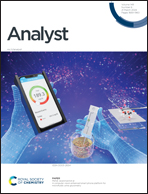Fast cancer imaging in pancreatic biopsies using infrared imaging†
Abstract
Pancreatic cancer, particularly Pancreatic ductal adenocarcinoma, remains a highly lethal form of cancer with limited early diagnosis and treatment options. Infrared (IR) spectroscopy, combined with machine learning, has demonstrated great potential in detecting various cancers. This study explores the translation of a diagnostic model from Fourier Transform Infrared to Quantum Cascade Laser (QCL) microscopy for pancreatic cancer classification. Furthermore, QCL microscopy offers faster measurements with selected frequencies, improving clinical feasibility. Thus, the goals of the study include establishing a QCL-based model for pancreatic cancer classification and creating a fast surgical margin detection model using reduced spectral information. The research involves preprocessing QCL data, training Random Forest (RF) classifiers, and optimizing the selection of spectral features for the models. Results demonstrate successful translation of the diagnostic model to QCL microscopy, achieving high predictive power (AUC = 98%) in detecting cancerous tissues. Moreover, a model for rapid surgical margin recognition, based on only a few spectral frequencies, is developed with promising differentiation between benign and cancerous regions. The findings highlight the potential of QCL microscopy for efficient pancreatic cancer diagnosis and surgical margin detection within clinical timeframes of minutes per surgical resection tissue.

- This article is part of the themed collection: SPEC 2022: International Conference on Clinical Spectroscopy


 Please wait while we load your content...
Please wait while we load your content...